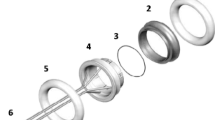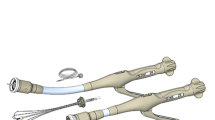Abstract
Background
Minimally invasive surgery is used increasingly for colonic resection. With this procedure, the involved colon is dissected laparoscopically and exteriorized through a small incision, and the segment containing the tumor is resected. The anastomosis is performed extraperitoneally either by hand suture or with a stapler. This study was designed to evaluate the feasibility of using a memory-shape compression anastomosis clip (CAC) to perform laparoscopically assisted colonic anastomosis. The study was prompted by the authors’ successful experience with the CAC in an animal model and in 10 patients with diverse colonic cancers.
Methods
The sample consisted of 10 patients who underwent laparoscopic colonic surgery at the authors’ center. The anastomosis was performed with the CAC for five patients and with a stapler for five patients. To perform anastomosis with the CAC, the two edges of the resected colon are aligned. Two 5-mm incisions are made near the edges, through which the CAC, after cooling in ice water, is introduced in an open position using a special applier. In response to body temperature, the clip resumes its original (closed) position, thereby clamping the two bowel loops together. At the same time, the small scalpel incorporated in the applier makes a small incision through the clamped walls for the passage of gas and feces, and the clip is released into the intestine. The two 5-mm incisions are sutured. The clip is expelled with the stool within 5 to 7 days, creating a perfect uniform anastomosis.
Results
Neither group had complications, except one patient from the control group who experienced a small bowel obstruction attributable to a wound suture problem, which required laparotomy. His recovery was uneventful.
Conclusions
The use of the CAC for colonic laparoscopic surgery is simple and very efficient, shortening operation time. It creates a uniform anastomosis, approximating the no-touch concept in surgery, and may prevent infection. It also is lower in cost than the stapler.







Similar content being viewed by others
References
CJ Cahill M Betzler JA Gruez (1989) ArticleTitleSutureless bowel anastomosis: European experience with the biofragmentable anastomosis ring Br J Surg 16 344–349
ML Corman ED Prayer TG Hardy SuffixJr MP Bubrick (1989) ArticleTitleComparison of the Valtrac biofragmentable anastomosis ring with conventional suture and stapled anastomosis in colon surgery Dis Colon Rectum 32 183–187 Occurrence Handle1:STN:280:BiaC2M3msl0%3D Occurrence Handle2646083
JK Croston DM Jacobs PH Kelley (1990) ArticleTitleExperience with the biofragmentable anastomotic ring—BAR—in bowel preoperatively irradiated with 600 rad Dis Colon Rectum 32 222–226
TG Hardy WG Pace JW Maney (1985) ArticleTitleA biofragmentable ring for sutureless bowel anastomosis: an experimental study Dis Colon Rectum 28 484–490 Occurrence Handle4017807
D Lifshitz M Michowitz M Raban A Jellin S Lelcuk (1993) ArticleTitleBiofragmentable anastomotic ring (BAR) in colonic surgery: a prospective randomized clinical study Coloproctol 5 306–310
IL Nudelman VV Fuko F Grief S Lelcuk (2002) ArticleTitleColonic anastomosis with the nickel–titanium temperature-dependent memory-shape device Am J Surg 183 697–701 Occurrence Handle10.1016/S0002-9610(02)00857-7 Occurrence Handle12095604
IL Nudelman VV Fuko S Morgenstern S Giller S Lelcuk (2000) ArticleTitleGastrointestinal anastomosis with nickel–titanium double ring World J Surg 24 874–877 Occurrence Handle10.1007/s002680010140 Occurrence Handle1:STN:280:DC%2BD3c3ptlGjsw%3D%3D Occurrence Handle10833258
I Ravitch (1982) ArticleTitleDevelopment of intestinal anastomotic devices South Med J 75 1520–1525 Occurrence Handle1:STN:280:BiyD28jmvFU%3D Occurrence Handle6755737
F Robiseck (1980) ArticleTitleThe birth of the surgical stapler Surg Gynecol Obstet 150 579–585 Occurrence Handle6987755
C Wullstein F Gross (2000) ArticleTitleCompression anastomosis (AKA-Z) in colorectal surgery: results in 442 consecutive patients Br J Surg 87 1071–1075 Occurrence Handle10.1046/j.1365-2168.2000.01489.x Occurrence Handle1:STN:280:DC%2BD3cvhvVarsg%3D%3D Occurrence Handle10931053
Author information
Authors and Affiliations
Corresponding author
Rights and permissions
About this article
Cite this article
Nudelman, I., Fuko, V., Rubin, M. et al. A nickel–titanium memory-shape device for colonic anastomosis in laparoscopic surgery. Surg Endosc 18, 1085–1089 (2004). https://doi.org/10.1007/s00464-003-9064-2
Received:
Accepted:
Published:
Issue Date:
DOI: https://doi.org/10.1007/s00464-003-9064-2




